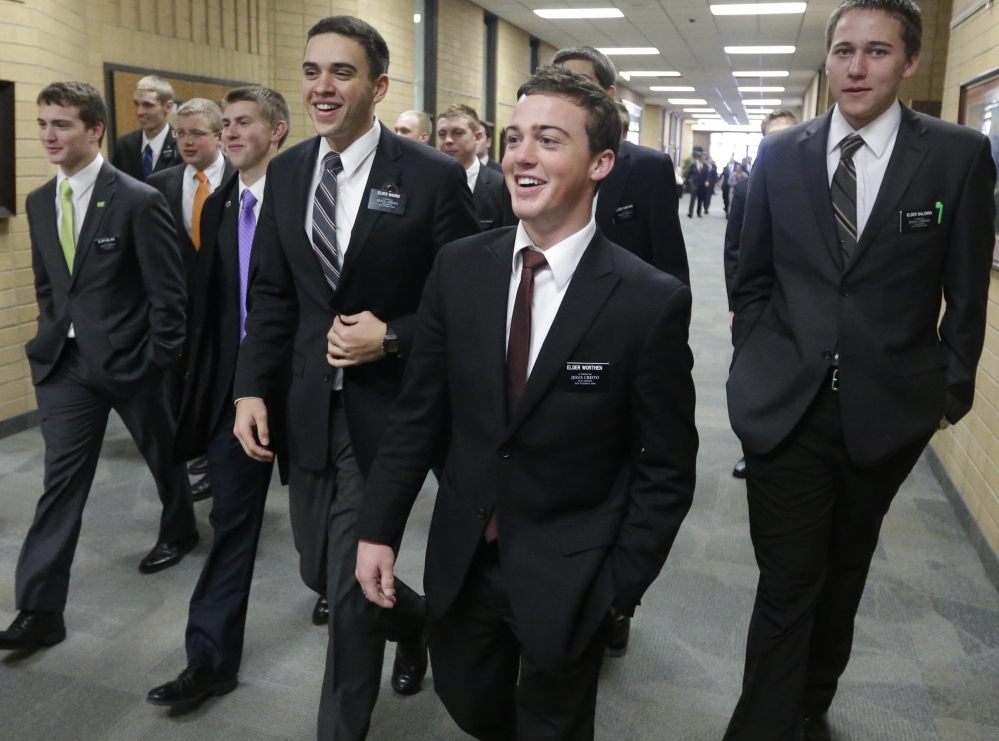SALT LAKE CITY — A record number of young Mormons signed up for missions after church leaders lowered the minimum age in 2012. But new figures show the onslaught of proselytizing Latter-day Saints didn’t lead to an equally dramatic spike in converts.
Statistics released by The Church of Jesus Christ of Latter-day Saints indicate there were 296,800 converts last year. The figure marked a 9 percent increase from two years ago, even though the number of missionaries increased by 44 percent.
The 85,150 missionaries serving at the end of last year were the most in Mormon history.
However, the average number of people converted per missionary, per year dropped to about 3.4 in each of the past two years – down from an average of five the previous decade, church figures show.
Mormon church spokesman Eric Hawkins said a number of factors may contribute to fewer baptisms per missionary, including a world that is increasingly secular. He said it would be a mistake to say missionary work is less impactful, pointing out that the number of converts last year was the highest since 1999.
Mormon scholars say the decline is most likely because the church sent many of its new missionaries to areas of North America that could quickly accommodate the sudden influx but were already flush with Mormons.
“All that’s going to do is increase how many missionaries aren’t converting anybody,” said Ryan Cragun, an associate professor of sociology at the University of Tampa who was raised Mormon but no longer belongs to the faith.
RECONVERTING PEOPLE
The figures also suggest it’s becoming more difficult to find people willing to convert to Mormonism, especially in highly developed parts of the world where people are less apt to turn to religion for help because their basic needs are being met, Cragun said.
Armand Mauss, a retired professor of sociology and religious studies at Washington State University, said the figures also might represent a shift to having missionaries focus on bringing inactive Mormons back into the faith.
Social scientists estimate that half or more of all converts stop attending church within a year of their baptism. As a result, new missionaries have likely spent time trying to “reconvert” people who strayed, Mauss said.
Today, missionaries are moving away from “conversion at any cost,” and aiming for retention and reactivation of non-participating converts, said Matthew Bowman, a history professor at Bowling Green State University in Ohio,
The Mormon church says it has 15 million members around the world, far fewer than much older denominations. By comparison, there are 1.2 billion Catholics, according to the Vatican. The Pew Research Center says there are 1.6 billion Muslims.
Mormon President Thomas S. Monson announced in 2012 that the church was lowering the minimum age for male missionaries from 19 to 18, and to 19 instead of 21 for women. No explicit goals or objectives were set for the new group.
David Evans, executive director of the Mormon church’s Missionary Department, said in 2013 that the change was primarily aimed at giving young church members more options to fit in a mission with other plans for college, military and marriage.
Hawkins called the response from young Mormons inspiring, noting that the church has expanded the number of missions to 407, up from 347 before the age change. Women are serving more missions than ever: 25 percent of missionaries are female now, up from 14 percent before the change, he said.
KEEPING THE FAITH
The fact that the church didn’t use the missionaries in potentially fertile conversion areas suggests its real intent in lowering the age was to prevent young church members from straying from the religion during the gap years that used to come between high school graduation and the start of missions, Cragun said.
Young people, no matter their religion, tend to begin questioning their upbringing and discovering new ways of thinking after leaving home for college, said Jan Shipps, a retired religion professor from Indiana who is a non-Mormon expert on the church.
Allowing Mormon men to go straight from high school to a mission “gives them two more full years embedded in the church,” Shipps said.
Matt Martinich, a member of the LDS church who analyzes membership numbers with the nonprofit Cumorah Foundation, said the decline in conversions is statistically significant and disappointing.
But it doesn’t’ mean the age change won’t have a positive, long-term impact for the religion, he said. Mormons who serve missions are more likely to go on to being full-fledged members of the church, often filling one of the many leadership roles needed to run local congregations.
Richard Bushman, a Mormon, historian and emeritus professor at Columbia University, doesn’t think the lower conversion rates suggest the church is struggling any more than usual.
“One thing for sure, the church will not stop trying to convert people, however difficult it may seem,” Bushman said. “That is part of who we are.”
Send questions/comments to the editors.



Success. Please wait for the page to reload. If the page does not reload within 5 seconds, please refresh the page.
Enter your email and password to access comments.
Hi, to comment on stories you must . This profile is in addition to your subscription and website login.
Already have a commenting profile? .
Invalid username/password.
Please check your email to confirm and complete your registration.
Only subscribers are eligible to post comments. Please subscribe or login first for digital access. Here’s why.
Use the form below to reset your password. When you've submitted your account email, we will send an email with a reset code.